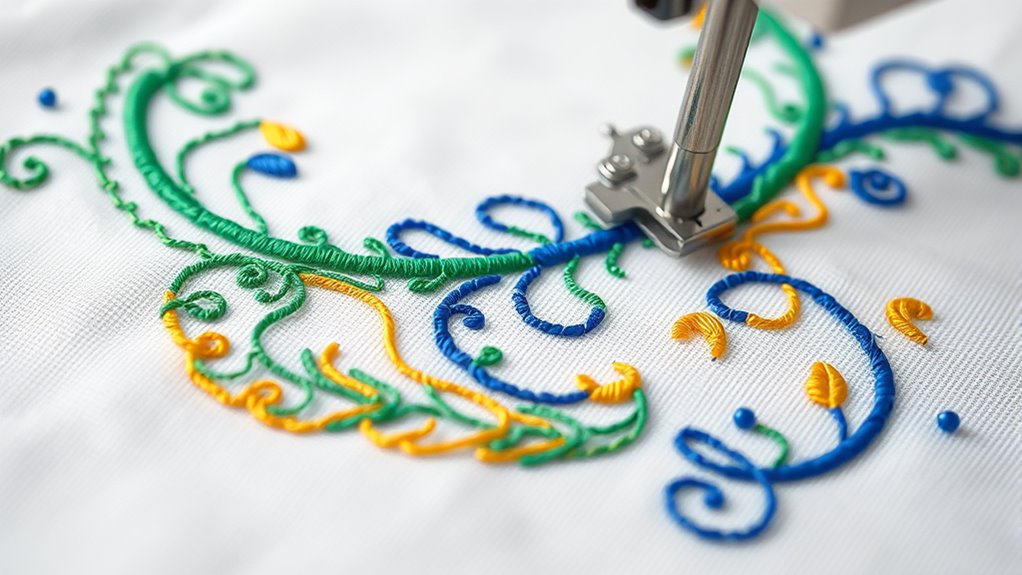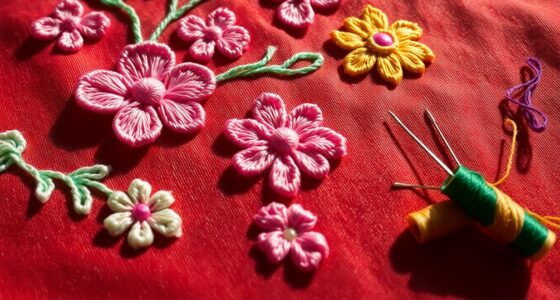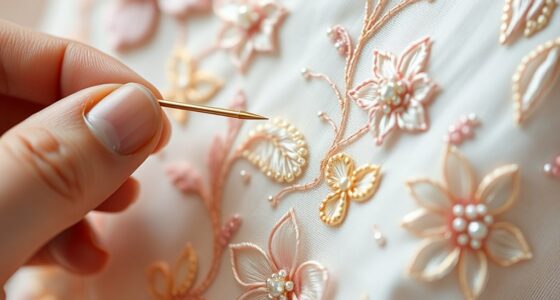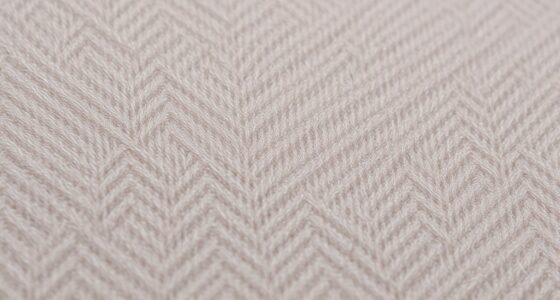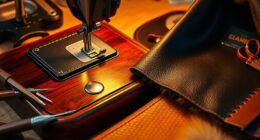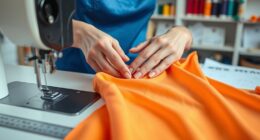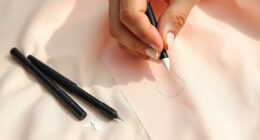Free-motion embroidery lets you create beautiful, flowing designs with a regular sewing machine. You control the fabric movements to draw directly with stitches, without needing hoops or special attachments. By practicing smooth hand movements and maintaining consistent stitch flow, you can produce intricate designs easily. Proper machine maintenance guarantees your stitches stay even and flawless. Keep exploring techniques and tips, and you’ll open endless creative possibilities with your machine.
Key Takeaways
- Free-motion embroidery involves controlling your sewing machine manually to create intricate, flowing designs without hoops.
- Practice steady hand movements and consistent stitch lengths to achieve smooth, artistic stitches.
- Regularly maintain your machine by cleaning and using appropriate needles to ensure stitch quality.
- Using a standard sewing machine for free-motion embroidery allows for personalized, detailed fabric designs.
- Combining skillful technique with proper machine care results in more precise, enjoyable embroidery projects.
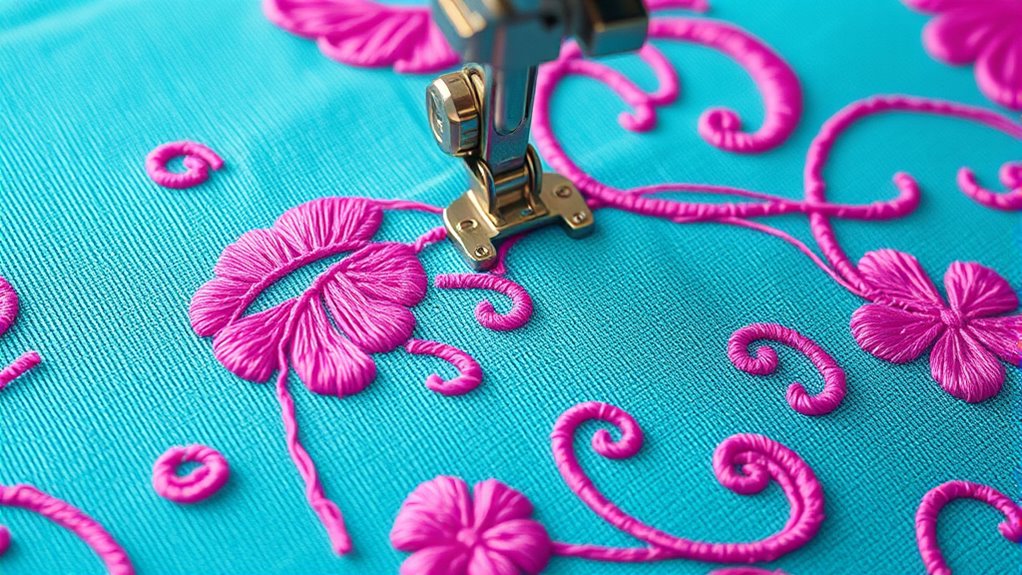
Have you ever wondered how to create intricate, free-flowing designs on fabric without the constraints of a hoop? Free-motion embroidery allows you to do just that, using your regular sewing machine to craft detailed, artistic stitches directly onto your fabric. The key to success lies in mastering the right stitch techniques and understanding your machine’s maintenance needs. Unlike traditional embroidery, which often requires special attachments or hoops, free-motion embroidery gives you the freedom to draw with your stitches, making it perfect for personalizing projects or exploring your creative instincts.
First, you need to familiarize yourself with stitch techniques that facilitate smooth, continuous lines. Moving the fabric freely beneath your needle lets you craft everything from delicate floral patterns to abstract designs. To do this effectively, you should practice controlling your hand movements and maintaining consistent speed. Keep your stitches even by practicing different stitch lengths and directions, experimenting with slow and steady motions. The more you practice, the more natural these stitch techniques will become, allowing your designs to flow effortlessly across the fabric.
Practice controlling your hand movements and maintaining consistent speed for smooth, continuous free-motion stitching.
Before diving into your project, it’s essential to guarantee your machine is in top shape. Regular machine maintenance plays a vital role in achieving flawless free-motion embroidery. Clean your machine’s bobbin case and feed dogs, remove lint, and oil moving parts according to your machine’s manual. This upkeep prevents skipped stitches and fabric jams, which can disrupt your creative flow. Using the correct needle size and type for your fabric also matters; a sharp, appropriate needle will produce cleaner stitches and reduce frustration. Always test your machine on scrap fabric before starting your main project to troubleshoot any issues with tension, stitch length, or stitch quality. Proper machine maintenance guarantees that your stitches are consistent and your machine runs smoothly, making the process more enjoyable and less stressful.
While practicing stitch techniques, remember that your machine’s stability depends on proper maintenance. Loose or dirty parts can cause irregular stitches or thread breaks, which derail your design and waste fabric. Keep your sewing machine covered when not in use and schedule regular check-ups if you sew frequently. With a well-maintained machine and refined stitch techniques, you’ll find free-motion embroidery becomes easier and more intuitive. You’ll gain confidence in your ability to control the movement and create intricate designs that reflect your personal style.
In essence, mastering free-motion embroidery on your regular sewing machine requires a combination of skilled stitch techniques and diligent machine maintenance. Good machine technology plays a significant role in ensuring consistent stitches and smooth operation. With patience and practice, you’ll reveal the full potential of your machine, transforming simple fabric into works of art. The more you experiment, the more you’ll discover new ways to push your creative boundaries, making every project uniquely yours.
Frequently Asked Questions
Can I Use Any Sewing Machine for Free-Motion Embroidery?
You can’t use any sewing machine for free-motion embroidery. While some sewing machines are compatible, others lack the necessary features like a free-motion mode or a darning plate. An embroidery machine is designed specifically for detailed stitching, but a regular sewing machine can work if it’s compatible and has the right features. Always check your machine’s capabilities before attempting free-motion embroidery to guarantee smooth results.
What Types of Threads Are Best for Free-Motion Embroidery?
You should choose embroidery thread types with good thread qualities like strength, smoothness, and colorfastness. Polyester and rayon threads are popular because they glide easily and produce vibrant stitches. Cotton embroidery threads are also great for a softer look. Avoid cheap or low-quality threads, as they can cause thread breaks and tangles. Using the right embroidery thread types guarantees your free-motion embroidery remains smooth and professional-looking.
How Do I Choose the Right Needle for Free-Motion Work?
Choosing the right needle for free-motion work is like selecting the perfect brush for a painting. You need needle sizes that match your thread and fabric, typically sizes 75/11 or 90/14, for smooth stitches. Opt for sharp, universal, or microtex needles to glide effortlessly through layers. Match your needle type to your project—ballpoint for knits, sharp for woven fabrics—ensuring your embroidery flows seamlessly, creating crisp, clean designs every time.
Are There Specific Fabrics Recommended for Free-Motion Embroidery?
You should choose fabrics with smooth textures and moderate weights for free-motion embroidery. Light to medium-weight fabrics like cotton, linen, or silk work best because they allow your needle to glide easily and hold stitches well. Avoid thick, textured, or stretchy fabrics, as they can be difficult to control. Experiment with different textures and weights to find what’s easiest for your skill level and desired effect.
How Do I Troubleshoot Common Issues in Free-Motion Embroidery?
To troubleshoot common issues in free-motion embroidery, start by checking your tension adjustments; uneven tension can cause puckering or skipped stitches. Make certain your stitch consistency by practicing slow, controlled movements and maintaining steady hand pressure. If stitches are uneven, recheck tension settings and your fabric grip. Also, replace dull needles and clean your machine regularly. These steps help improve stitch quality and prevent common problems like thread breakage or inconsistent stitching.
Conclusion
So, who knew that your trusty sewing machine could double as an artist’s brush? With a little practice, you’re now armed with the incredible skill of free-motion embroidery—no fancy equipment needed. Irony strikes; this simple, accessible technique turns your everyday sewing machine into a masterpiece creator. So go ahead, embrace the unexpected. After all, it’s hilarious how the ordinary can produce extraordinary art—proof that you don’t need fancy tools to create something beautiful.
